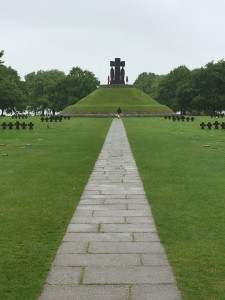After our time in London, the trip took a more relaxed turn as we took the ferry across the channel to Normandy, France. Leaving the hustle and bustle of an international city for farmlands and quiet villages, we saw a slow down in tempo. This was apparent in our base city of Bayeux. A sleepy town, it could be easily fully explored in a day. Our six days in Normandy were comprised of day trips to different World War II sites. From Omaha Beach to Pegasus Bridge and Pont du Hoc, these sites brought to life both the importance and struggle of D-Day and Operation Overlord.

German cemetery, note the dark crosses
In terms of personal experience, none of the actual battle sites compared to the three cemeteries we saw. The American, British and German cemeteries all presented a harrowing look at both the human cost of the battle for Normandy as well as national remembrance of those lost. The German cemetery was by far the most interesting (to me at least) out of the three. Rows and rows of dark gray stones shaped like rudimentary Iron Crosses were the common features.They all surrounded a large monolithic dark grey cross on top of a small hill, flanked by similar colored statues of a bishop and a woman, heads bowed. The neoclassical Christian imagery was blatantly obvious.
An aspect that was completely different than the British and American cemeteries was the information on the headstones. They only contained the soldier’s name, rank and date of birth. It seemed like this represented the collective shame of Germany following the war. These soldiers, many only 18/19 or 35-40, were demonstrative of an aggressive war caused by a genocidal regime. Obviously I’m not by any means AT ALL defending the actions of German soldiers, but many of those stationed in Normandy could simply be fighting for their country and not Nazi ideology. It might’ve been the weather (50 and rainy – Columbus weather in the spring) that amplified my experience, but the cemetery’s sense of muted shame that hit me the hardest.

British cemetery just outside of Bayeux.
The British and American cemeteries were obviously quite different, somewhat due to the idea that (sorry I’m not sorry for the cliché) history is written by the victors. Staggering in numbers, they were solemn and justified in appearance. Tall white crosses with name, age, and regiment for the Americans. Similarly for the British, the cemetery was comprised of white headstones with that information plus a small eulogy. The white crosses contrast heavily with those in the German cemetery, pure, clean and clear of mosses. It was clear these soldiers needed to be remembered and rightfully so for what they sacrificed against tyranny. As Eisenhower stated, they had embarked on “the Great Crusade,” and paid the ultimate price.
Up next, Paris, the City of Lights, which will be incredibly interesting. We’ve gotten a taste of what the French countryside holds, now we will see what the biggest city has in store.
